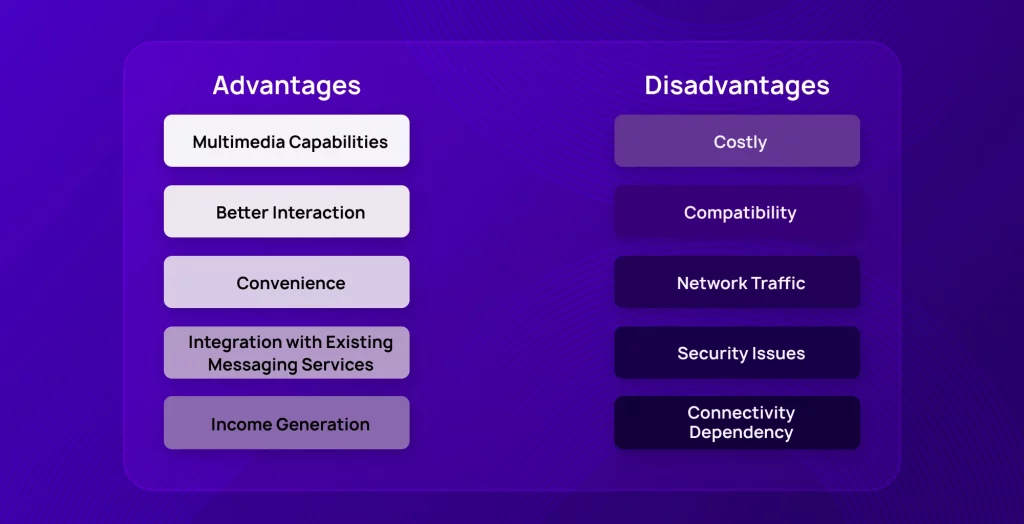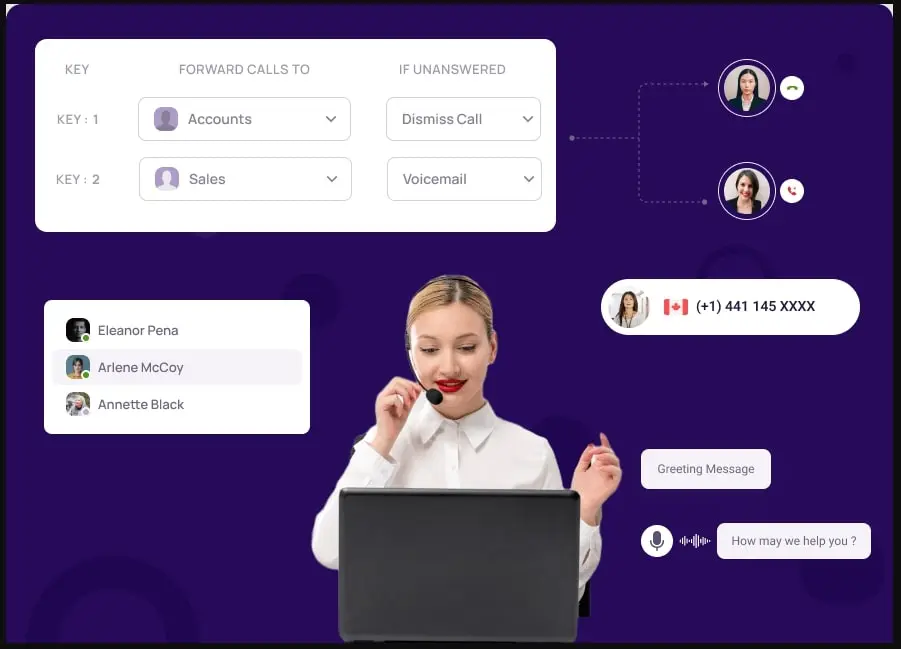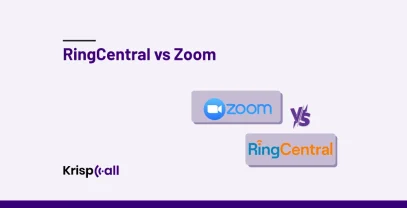In today’s world of instant gratification, where visuals reign supreme, text just doesn’t cut it anymore. That’s where Multimedia Messaging Service (MMS) comes in, allowing you to send photos, videos, and audio clips.
But have you ever wondered how those MMS messages zip between phones? The secret lies in Multimedia Messaging Service Centers (MMSCs)!
Find here everything you need to know about multimedia messaging service center: What is it, how does it work, its importance, use cases, and many more.
Keyhighlights🔑
- Multimedia Message Service Center allows mobile devices to send and receive messages to mobiles
- Some of its important aspects include multimedia messaging, enhanced communication, media distribution, and integration with other services.
- It is widely used by team operations and enterprises for marketing campaigns and education and training.
- Its advantages are Multimedia Capabilities, Better Interaction, Convenience, Integration with Existing Messaging Services, and income generation.
- You can send your important MMS through KrispCall so that you can maximize your professional communication.
What is a multimedia messaging service center?
A Multimedia Messaging Service Center (MMSC) is an important component of mobile telecommunications networks that enable mobile devices to send and receive messages consisting of multimedia objects like images, videos, and so on. It facilitates smooth communication over wireless networks, handling tasks such as receiving, storing, forwarding, and delivering messages.
The MMSC stores and forwards SMS transmitted over mobile operators. The MMSC may also serve a formatting role by allowing messages to be adapted to the abilities of the device being sent to. Also, it handles various aspects that include sending and receiving MMS messages, ensuring seamless delivery of MMS messages through the MMS proxy.
The time it takes to deliver a multimedia message through this technology differs based on several factors, including network outages, access points, recipient network connectivity, MMSC performance, the sender and the recipient’s geographical location, as well as the mobile operator infrastructure involved.
Example: Ever sent a photo or video to a friend? Thank the MMSC!It’s like a super-fast delivery service for your media messages. Just hit send, and the MMSC ensures your message reaches your friend in a short time. So, whenever you share a moment, remember the MMSC making it happen effortlessly!
Importance of MMSC in modern communication
MMSC provides many advantages in modern communication by facilitating the exchange of multimedia stuff which includes images, audio clips, and rich text.
Emergency Communication
MMSC can be important in emergency communication conditions where quick dissemination of multimedia information is essential. Emergency alerts, such as Amber Alerts or weather warnings, can be efficiently delivered to a large number of recipients using MMSC infrastructure.
Enhanced Communication
MMS provides more expressive communication than regular SMS (Short Message Service). Users can submit images of memorable occasions, videos of events, or voice recordings to add depth and emotion to their messages.
Media distribution
MMS centers make it easier to reach a large audience with media content, including news updates, entertainment snippets, and promotional materials. This capacity is very useful for media organizations and content creators who want to distribute their content to mobile device users.
Integration with Other Services
MMS centers can be paired with other services like email, social media platforms, and cloud storage to allow for effortless sharing and storage of multimedia material across many channels.
Applications of MMSC: Where is it Widely Used?
MMSC supports a wide range of formats, links, and web access without incurring additional costs. It is widely used in:
- Business Marketing: Businesses can use MMSC to send marketing messages to their customers. These messages can include coupons, promotions, and other marketing materials.
- Enterprises for Marketing Campaigns: In business, an MMSC (Multimedia Messaging Service Center) is a unique center that enables you to send engaging messages that include photos, videos, and other content. Companies can use it to inform customers about new items, provide special offers, and also invite them to events. It is also used to create engaging messages that are delivered directly to people’s phones.
- Emergency services and public alerts: MMSC is essential for emergency services and public alerts. It enables the speedy distribution of important information during emergencies such as natural disasters or public safety issues. This ensures citizens receive timely and comprehensive information, which improves emergency response and public safety.
- Person-to-Person Messaging: The most common application of MMSC is for person-to-person messaging. This allows users to send and receive MMS messages between mobile phones.
What are the advantages and disadvantages of MMSC?
MMSC provides users with lots of advantages by offering a rich and diverse communication experience. Also, its reliance on network coverage may pose a disadvantage in areas with poor connectivity. There is also a concern regarding potential security vulnerabilities that users should be aware of.

Advantages of MMSC
With its multiple features, it provides lots of benefits to small and enterprise-level businesses. It helps businesses to grow ensuring faster communication. Here are some of its advantages:
- Enhanced User Experience: By supporting multimedia content, MMSC enhances the user experience compared to traditional text-based messaging services. Users can express themselves more creatively and vividly, leading to more engaging conversations.
- Better Interaction: MMSC allows users to send and receive messages more efficiently by integrating multimedia elements, which enhances the communication experience as compared to standard text-based texting.
- Convenience: MMSC allows users to share memories, experiences, and information with others via multimedia material, independent of geographical location.
- Integration with Existing Messaging Services: MMSC works smoothly with existing messaging services, allowing users to send to contacts via phone numbers or email addresses.
- Income Generation: Mobile carriers can generate income from these services by charging customers to send and receive multimedia messages or by offering premium multimedia services.
Disadvantages of MMSC
There are also disadvantages of MMSC as it can be costly for some users and also cannot be available in every location. Here are some of its disadvantages:
- Costly: Multimedia communications using this process can result in higher charges for users than text-based texting.
- Compatibility: When messages are exchanged between various devices or networks, they may encounter formatting issues or delivery failures.
- Network Traffic: MMSC usage adds to network congestion, resulting in delays or failed deliveries at peak hours.
- Security Issues: Multimedia transmissions are susceptible to interception, illegal access, and virus attacks, and incorrect settings
- Connectivity Dependency: MMSC operation is dependent on network availability, which might cause disruptions in locations with inadequate coverage.
The Evolution of Multimedia Messaging
It originated in the early 2000s with the introduction of the Multimedia Messaging Service (MMS) which allowed users to share images, audio, and videos alongside text messages.
Moving away from typical SMS, MMS expanded communication boundaries by allowing the sharing of rich multimedia content, paving the door for more expressive and engaging interactions.
The Multimedia Messaging Service Center (MMSC) was a critical component in this progression, serving as the backbone infrastructure for multimedia message transmission across various devices and networks.
Challenges in multimedia communications
- Bandwidth Constraints: Multimedia communication that can be photographs, videos, or audio files necessitates appropriate bandwidth, which can be constrained in particular network circumstances, resulting in delayed or unsuccessful message delivery.
- Managing platform limitations: Multimedia messages may not display properly on different devices, operating systems, or messaging platforms due to changes in file formats, codecs, or display capabilities.
- Network Congestion: Large volumes of multimedia communications can cause network congestion, resulting in message delivery delays or failures, especially during high usage periods.
- Security and Privacy Issues: Multimedia messages may contain sensitive or private information, making them vulnerable.
What are the Future Trends in MMSC?
Future trends in Multimedia Messaging Service Centers (MMSC) are projected to prioritize improving user experiences through advanced technologies like AI used in call centers which can be used in multimedia call centers, augmented reality (AR), and virtual reality (VR).
MMSCs are expected to use AI algorithms to improve content categorization, recommendation systems, and automated content generation. These developments will allow consumers to receive more personalized and relevant multimedia messaging experiences as AI systems learn from their preferences and habits to produce tailored information.
Integrating augmented reality (AR) and virtual reality (VR) features into MMSC platforms has the potential to alter multimedia communications experiences. AR and VR technology will allow users to create and share immersive and interactive multimedia material, expanding communication options. From virtual encounters to shared experiences,
Send MMS Messages to Clients/Colleagues Effortlessly through KrispCall
Send multimedia messages to clients and coworkers easily by incorporating pictures and documents into your chats through KrispCall. KrispCall allows you to successfully deliver information while also ensuring that your SMS messages stand out. Say goodbye to traditional text-only communication and embrace the convenience of MMS messages with KrispCall now.

Conclusion
The Multimedia Messaging Service Center (MMSC) is an essential component of modern communication that allows for a smooth transfer of multimedia communications.
Professionals can use the features of MMSCs like KrispCall to improve their communication strategy by smoothly incorporating multimedia components into talks. Whether discussing project updates with coworkers or displaying product graphics to clients, the ability to transmit information via multimedia improves comprehension and engagement.





